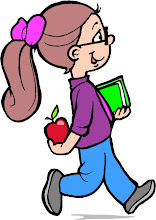Our Book Study was Winnie-the-Pooh by A.A. Milne (1926). I have a book titled The World of Pooh which contains the complete Winnie-the-Pooh and The House At Pooh Corner. We started reading it during Week 25, and just have a three more chapters until we complete the book. Here are activities from Games with Books which go along with Pooh.
- The Hum Game -- to practice the ability to rhyme with ease and play with words
- Pooh has a very relaxed approach to rhyming, and so does K., she loves to rhyme, so this was a very fun game for us.
- How to Play: Pick a topic and make a two line rhyme. Then your child picks a topic and makes us a two line rhyme. Keep going back and forth for as long as you want to. This is a great way to make waiting somewhere more enjoyable.
- Variations:
- Instead of picking your own topics, pick for each other.
- I like to add a "Rum-tiddly-pum" after each rhyme.
- If someone has trouble thinking of a rhyme for a topic, the other person can give suggestions.
- Make A Bear -- great for small muscle development
- You'll Need: fabric (an old white t-shirt works great), cotton balls, permanent marker, scissors, thread, needle, straight pins, pattern of bear on page 181 of book
- Cut two pieces of fabric large enough for the pattern
- Pin the pattern to both pieces of cloth.
- Let your child cut the bear out. You can help, if needed, but let your child so as much of the cutting as possible.
- Remove the pins and the paper bear pattern.
- Make sure the front and back of the bear are aligned and pin them back together.
- Thread the needle and (on extra fabric) show your child how to do a running stitch. Don't make the thread too long, or it will tangle.
- When he has the idea, let him start sewing the bear. Sew about a quarter inch from the edge.
- When the thread is almost gone, knot it and re-thread the needle.
- Make sure to leave an opening of an inch or two to turn and stuff the bear.
- Turn the bear inside out.
- Stuff the bear with cotton balls (or if you prefer a bean bag, with beans). fill the arms, legs, and head first, then the body.
- Have your child stitch up the opening and check for gaps in the sewing that need to be fixed.
- Let your child use the permanent marker (or fabric paint) to draw a face and decorate the bear in any way she chooses.
- Wobbly Letters -- practice finding misspelled words
- Pooh's spelling wobbles and the letters get in the wrong places.
- How to Play: Write a simple sentence and misspell a word. Have your child identify the misspelled word. If they spell it correctly on the first try, they get 2 points. If they correct it on the second try, they get 1 point. Let your child can play with the spelling on a paper until they think it is correct. Play this eight times. If your child earns at least 10 points, they win, if they earn less than 10 points, you win.
- Pooh Picnic Party
- If your child invites friends, it should be just 1 or 2 people.
- Everyone brings their favorite stuffed animal.
- The menu consists solely of foods that start with the p sound, except for honey.
- Include your child in all the preparations, from writing invitations to helping choose the menu and preparing the food to decorating and cleaning up afterwards.
K. earned her $2 for saying Psalm 129 on Wednesday! We also played math games and read books about birds this week.






